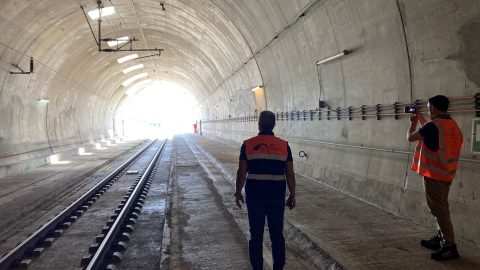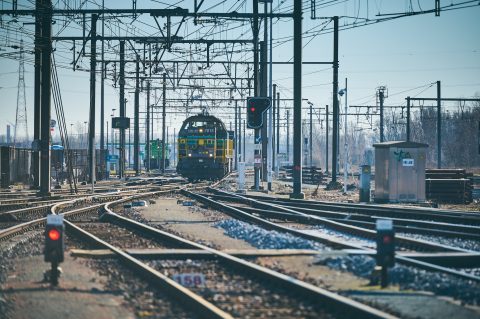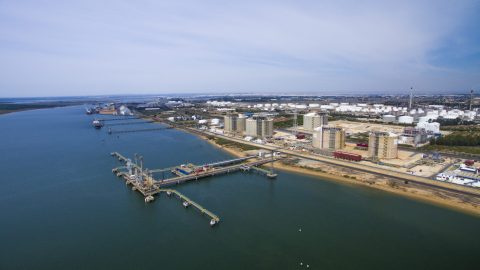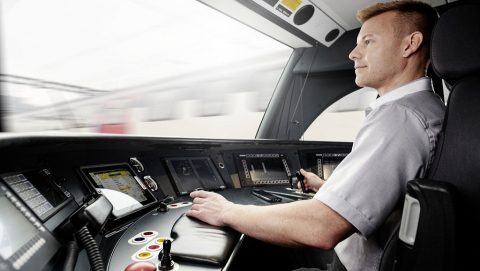‘Electrification Germany not fast enough, virtually nothing happened’

The electrification of the rail network in Germany is progressing slowly, while a clear target of 75 percent by 2030 is set. “Virtually nothing has happened in Germany since 2019. Just 61 percent of the rail network is electrified”, said Dirk Flege, managing director of the Pro-Rail Alliance. The rising costs of construction could play a role, as the cost-benefit analyses of electrification have a higher chance of falling in favour of not electrifiying.
The German federal government plans to electrify 75 percent of the route network in Germany by 2030. This was stated in the coalition agreement between the three parties (SPD, FDP and the Greens) who have formed the government since 2021. “This goal is becoming ever more distant,” said Dirk Flege of the Allianz Pro Schiene.
500 kilometres per year
The federal railway network in Germany currently covers 33,400 kilometres. Most recently, a good 65 kilometres per year were newly fitted with overhead lines, according to the Pro-Rail Alliance. “In order to achieve the federal government’s goal, however, 500 kilometres per year would have to be electrified. In a Europe-wide comparison, the lack of dynamism in this country is shameful”, said Flege.
In fact, in the previous coalition agreement of February 2018, the CDU / CSU and SPD, agreed to electrify 70 per cent of the rail network in Germany by 2025, which is also not in view. A 9 per cent increase in electrification in three years is unlikely with the current electrification rate.
Large portion of rail freight already electric
Interestingly, 90 per cent of rail transport services in Germany are provided electrically today. This can be explained by the fact that 74 per cent of all train kilometres are covered electrically. This is because the sections with the most traffic are electrified. Electric trains also carry significantly more goods per train than diesel trains.
But this observation does not justify the slow progress in electrification according to the Pro-Rail Alliance. Flege: “It is true that 93 per cent of the current transport performance in rail freight transport is provided electrically.
However, if truck transport is to be shifted to the rails on a large scale, then the previously non-electrified rail routes must also be fitted with overhead lines. Freight trains need overhead lines over long distances, they won’t get very far with alternative drives.”
For freight, electrification gaps are often on federally-owned first and last mile sections of the network. As a result, railway undertakings often use diesel locomotives over the entire route, said the Federal Ministry for Digital Affairs and Transport last year in the the electrification plan for the railways. Electrification can increase the incentive to run the entire route with electric traction.
Cost effective?
As with all investment projects, it is legally binding to also observe the cost-effectiveness when electrifying routes. This means that only projects that bring at least as much macroeconomic benefit as they cost may be implemented. Therefore, many projects were checked for their so-called benefit-cost value.
In total, the federal states, associations and infrastructure manager DB Netz proposed 173 routes for investigation, of which just 34 were selected for freight electrification on the basis of a catalogue of criteria and subjected to a macroeconomic evaluation. As a result, it was found that – in addition to the rail requirement plan – eight additional electrifications for freight traffic would make sense.
According to the transport ministry, almost all electrifications for freight transport that are economically viable are already covered by the rail requirements plan. There are also still non-electrified routes that are used by freight trains once or several times a day, they admit. However, the study “Electric Freight Railway” showed that electrification with contact wire is currently ‘not worthwhile for the taxpayer’. As with (regional) passenger traffic, alternative drives should be used here in order to close the existing electrification gaps, it is stated.
Rise of construction costs endangers electrification projects
A cost-benefit for large infrastructure projects is the standard, and not without good reasons. However, the currently skyrocketing costs of construction could make reaching the electrification goals even more of an uphill climb. With a 40 per cent increase in construction costs , almost a dozen routes could slip below the threshold, said Lukas Iffländer from the passenger association Pro Bahn to the Tagesspiegel. The cost-benefit study of the current Federal Transport Infrastructure Plan is ‘hardly meaningful’. Some calculations for electrification of passenger routes would be based on incorrect assumptions, he says. “The number of passengers forecast for 2030 was already reached in 2019”, says Iffländer.
In fact, Iffländer advocates forgoing the cost-benefit analysis entirely when it comes to electrification. An overhead line should be approved as standard for a certain number of trains, otherwise, the federal government will miss its goal of electrifying 75 per cent of the route network by 2030, says Pro Bahn.
Who should take action?
In Germany, the Federal Transport Infrastructure Plan (Bundesverkehrswegeplan) which runs until 2030 forms the basis for the federal government’s draft law to amend the expansion laws for federal railways, roads and waterways, for which plans are made in so-called requirement plans (bedarfsplane).
The investment activity in the rail requirement plan had been declining since 2010, but has been upped again in recent years. The current funding line is around 1.6 billion euros per year and will increase to two billion by 2023. How quickly the further electrification of the railways progresses depends not only on the implementation of the rail requirement plan, but above all on the speed of electrification in regional rail transport, according to the transport ministry. This is because this is where the electrification gap is the greatest. “It is now up to the federal states responsible for rail passenger traffic to set concrete electrification targets and close the gap quickly”, it was stated by the ministry at the end of last year in the electrification plan.
Especially for regional transport, instead of looking at the electrification as equipped on the infrastructure as a measure, the transport ministry proposed to use the parameter “electrical operating performance”, in other words the percentage of train kilometres travelled that are covered electrically. This also covers alternative drives, and taking a look at the coalition agreement, it is not detailed that the 75 percent refers necessarily to overhead line electrification.
According to the Pro-Rail Alliance, which is highly in favour of electrification of the infrastructure, there is now an important task for the federal government, however. Dirk Flege: “The federal government should really quickly simplify the planning law for the subsequent electrification of already built rail lines”.
This article was first published on Railtech, our sister publication.
You just read one of our premium articles free of charge
Want full access? Take advantage of our exclusive offer





Electrification, optimal when steam was shifted out, regrettably no longer is.
Redundancy, resilency and robustness!…, now serious bottlenecks of railways, decisively have to be attended!
(Electrification, yes, but a timely!)
Disturbings, simply related parameters, by old standards, shall be outed from railway infrastructure!
(In the mean time, pragmatically, any alternative, by diesel…, etc. is better than, current, for majority – by on road trucks…)